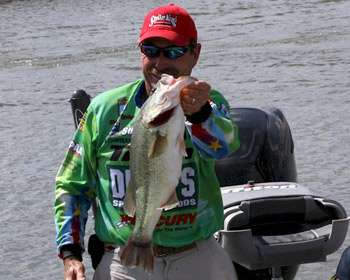
"If you can see the bass, it's sight fishing."
So says Florida pro Shaw Grigsby matter-of-factly. It would seem to be an obvious point, but most weekend anglers think that sight fishing only occurs when bass are locked on the beds.
"The first thing everyone thinks of when you say sight fishing is spawning," he explains. "In stained and dirty water, you can't see very deep, so probably the only time they're in a foot or foot and a half of water and you can see them is during the spawn. But in clear water situations you can sight fish all year. In fact, at Lake Mead and some of the springs in Florida, we have places that are crystal clear where you can read a newspaper in 30 feet of water and you can sight fish all year. Even when it's freezing cold you can sight fish."
Grigsby often reminisces about a tournament that he "should have won" years ago on Buggs Island that proves his point: "I was flat stomping them sight fishing, and it was a September tournament," he remembers. "I'm talking fairly skinny water, back in pockets where there were wolf packs of big bass that were just corralling shad. They'd see something swimming along and they'd just attack it. They were like piranha — I'd take a tube bait and as soon as I'd spot them I'd throw it out about 10 feet in front of them and they'd just fight each other to go after the tube bait. There were a lot of three-, four-, five- and some six-pounders in there.
"Well, tournament time came and we had some clouds and some wind and it really blew the sight fishing for them. I had to blind cast for them, and I caught a few but I didn't have any of the success that I had in practice."
The key aspect of sight fishing when you're not in the spawn is stealth. You have to make your cast before the fish knows you are there. The idea is to see him and make a presentation that will excite the fish without him seeing you.
The one non-negotiable piece of equipment in this pursuit is topnotch sunglasses.
"They've got to be polarized," Grigsby says. "I prefer glass lenses — your clarity is just better — but polycarbonate is OK. I prefer yellows, ambers and light browns. That collects sunlight. A gray lens, in bright sunlight might be OK but it doesn't give you the contrast, plus the yellow picks up detail. And the dark glasses, if it's a cloudy day, you're going to take them off, so you don't have the protection and you can't really see that well anymore. They're not doing you a whole lot of good at that point.
"The fourth thing that you want is ultraviolet blockage. That'll protect your eyes from cataract damage — something that can come on later on in life that you don't think of when you're younger. Get yourself a pair that fits nice, a pair that's comfortable on you. If you've got a pair that's not comfortable, and you've got temple pressure or pressure on the bridge of your nose or behind your ears, then a lot of times it causes headaches or pressure points and all of a sudden it's bothering you and you're concentration is now broken. You have to be concentrating to be competitive and catch fish. If they're comfortable, you can put them on and forget you have them on."
With his glasses on, he puts the trolling motor down and starts looking, but there's a method to his madness.
"I usually put my boat in at a certain depth, and by watching my electronics, I try to see to the bank and down to the deepest water that you can see. If it's about five feet of visibility, I might be sitting in five or I might be sitting in three, where I can get a little bit over to the right and then all the way over to the bank."
Once the boat is positioned correctly, it becomes a game of hide and seek.
"I just head down the bank, and I'm usually throwing bait like the Strike King Z-Too or the Caffeine Shad, a soft plastic jerkbait," he says. I like a soft plastic bait like the Z-Too because when I make that cast and I'm twitching it, it's pulling the fish to it. So a lot of times I'll see that fish when it's moving to the bait if I don't pick it out just swimming. That allows me to pause it, settle it and get it in front of the bass. A soft plastic jerkbait won't just sit there or float back to the surface. It has that depth range so you can really make it look like a dying shad, which makes it a really good search bait. But when I spot a fish, they'll eat that Caffeine Shad and the Z-Too, but the best single bait I have for catching a sight fish is the tube bait."
Once he spots them, they're dead meat — and the tournament fates of anglers who stop looking when the fish are done reproducing are equally dead.
(Provided exclusively to BASS Insider by Z3 Media)





